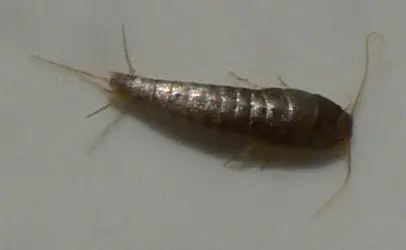Every book seller has opened up a box and gotten the occasional surprise critter. Or moved something and suddenly seen something scurry off. Eeep! Most creepy crawlies are harmless to you but they are still a cause for concern. Many wee beasties think your books are delicious! If you spot them in an incoming box, they’ll also give you a clue where these books were kept. Or if you’re out at a tag sale, estate sale, or op shop, spotting these beasts lets you know to go shop elsewhere.
All of the following creepy crawlies like HIGH humidity. If the humidity dips below about 60% they’ll shrivel up and die. So if you see these beasts in an incoming box you know it’s been somewhere DAMP and that means mold and water damage are very likely.
Do note: these critters are all harmless. They can’t sting you, bite you, or make you sick. They can just give you a fright. There’s pictures of bugs beyond the jump, so the faint of heart may want to skip the rest of this article…
Lepisma saccharina
Going by the name silverfish, fishmoth, carpet shark, or paramite these little insects love to chew on books. They’re silver and shiny and move with a distinct wiggling motion like they’re “swimming” across the surface. They’re usually no bigger than an inch long (2.5 CM). They’re harmless to humans and don’t spread disease. However they can badly chew up books, so spotting these guys in a box is a bad sign. Books that have been gnawed on by silverfish have a distinct nibbled appearance on the edges.
They are found worldwide, but North America has two additional similar looking species.
Thermobia domestica also known as Thermophila furnorum
The firebrat is very similar to the silverfish in habitat and behavior but likes it HOT. Indoors they like warm, hot places like boiler rooms, muggy attics, laundry rooms, kitchens, etc. They’re brownish and about half the size of silverfish. Again, they don’t spread disease but will eat books.
They are found worldwide, generally in warm climates but can be found indoors in colder areas.
Psocopterans
There’s over 5000 species of booklice, barklice, and barkflies. These are tiny little chewing insects that generally don’t get more than 1 cm or 1/3 an inch in length. They’re scavengers and will eat the glue in bindings… but most are really interested in mold. If you see these guys, it’s almost guaranteed there’s mold around.
The various species are found worldwide and since they’re small are hard to tell apart. If it doesn’t have wings, it’s more likely to be a bit more destructive than the flying ones.
Oniscideans
There’s over 3000 different species of woodlouse… also known as armadillo bugs, doodlebugs, pill bugs, potato bugs, roly-polys, sow bugs, slaters, butchy boys, and wood bugs. Despite the common name including “bug” these are actually little crustaceans… meaning they’re more closely related to lobsters than silverfish, firebrats, and booklice. They’re small (fingernail size or smaller) and harmless to humans. They generally like to eat decaying material, so aren’t a direct threat to books. However, since they breath through gills they need VERY high humidity to survive. If you see these guys near books, it’s DAMP. You probably want nothing to do with those books.
These guys are found worldwide. There’s many different native species but if you’re in Europe or North America, you’re most likely to see Armadillidium vulgare which was accidentally introduced from the British Isles. Armadillidium vulgare can curl all the way up into a ball, other species can’t. (I personally think these guys are cute, but I’m probably in the minority here…)
These four critters can’t hurt you, but you don’t really want them in your shop either. They all like high humidity so if you do accidentally get some in a box, propping the books somewhere to dry in the sun for a day will probably get rid of them. (if you can salvage the books at all) They’re nothing to be frightened of, just be aware that they’re red flags that that box has been somewhere damp!





Nora,
I recognize these beasties, but the idea of using them as indicators rather than just attempting to eliminate them hadn’t occurred to me. Thanks for the excellent information.
I’ve never seen them inside a building except for in an old home where after a few days of vacation, a silverfish might be waiting just above a drain to welcome us back. I’ve accepted many tattered boxes of donated books, too. Are they just more apt to make their homes inside books in humid climates? I know they can be found in Oregon where I live, but they don’t seem interested in our stacks. Or maybe I’ve just been fortunate?
They require above 60% humidity to survive, so dry habitats will kill them. Good ventilation in a shop can keep them at bay.
The climate in Oregon probably also keeps them from getting too prevalent. Warmer climates they can also live outside in their natural habitat and thus escape attempts to eliminate them. Colder areas the outdoor population may be wiped out during the winter, so they have to repopulate house to house.
I generally only see silverfish here (CT) in summer weather. Pillbugs you can find even in winter wedged in logs where the decaying wood generates enough heat to keep them from freezing. I’ve never seen firebrats or booklice, which seem to like it consistently hotter.
Connecticut and Oregon are both in the same climate zone (zone 6 on a hardiness map), so have similar temperatures. One climate zone south may be enough for creepy crawlies to overwinter a little better. The extreme southern states may have no winter die off at all. (though, by same token, predators of these critters are also active year round)